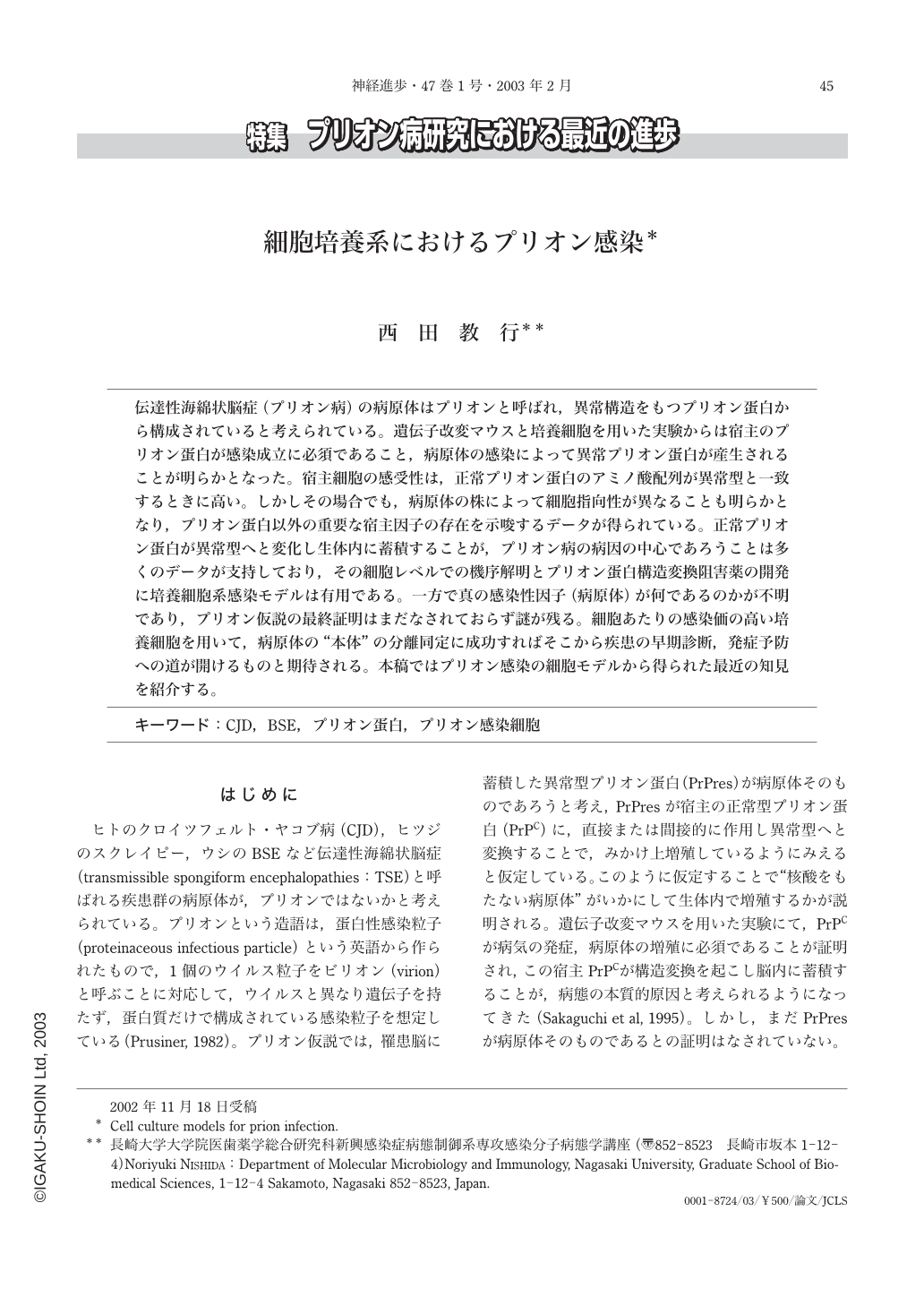Japanese
English
- 有料閲覧
- Abstract 文献概要
- 1ページ目 Look Inside
伝達性海綿状脳症(プリオン病)の病原体はプリオンと呼ばれ,異常構造をもつプリオン蛋白から構成されていると考えられている。遺伝子改変マウスと培養細胞を用いた実験からは宿主のプリオン蛋白が感染成立に必須であること,病原体の感染によって異常プリオン蛋白が産生されることが明らかとなった。宿主細胞の感受性は,正常プリオン蛋白のアミノ酸配列が異常型と一致するときに高い。しかしその場合でも,病原体の株によって細胞指向性が異なることも明らかとなり,プリオン蛋白以外の重要な宿主因子の存在を示唆するデータが得られている。正常プリオン蛋白が異常型へと変化し生体内に蓄積することが,プリオン病の病因の中心であろうことは多くのデータが支持しており,その細胞レベルでの機序解明とプリオン蛋白構造変換阻害薬の開発に培養細胞系感染モデルは有用である。一方で真の感染性因子(病原体)が何であるのかが不明であり,プリオン仮説の最終証明はまだなされておらず謎が残る。細胞あたりの感染価の高い培養細胞を用いて,病原体の“本体”の分離同定に成功すればそこから疾患の早期診断,発症予防への道が開けるものと期待される。本稿ではプリオン感染の細胞モデルから得られた最近の知見を紹介する。
はじめに
ヒトのクロイツフェルト・ヤコブ病(CJD),ヒツジのスクレイピー,ウシのBSEなど伝達性海綿状脳症(transmissible spongiform encephalopathies:TSE)と呼ばれる疾患群の病原体が,プリオンではないかと考えられている。プリオンという造語は,蛋白性感染粒子(proteinaceous infectious particle)という英語から作られたもので,1個のウイルス粒子をビリオン(virion)と呼ぶことに対応して,ウイルスと異なり遺伝子を持たず,蛋白質だけで構成されている感染粒子を想定している(Prusiner, 1982)。プリオン仮説では,罹患脳に蓄積した異常型プリオン蛋白(PrPres)が病原体そのものであろうと考え,PrPresが宿主の正常型プリオン蛋白(PrPC)に,直接または間接的に作用し異常型へと変換することで,みかけ上増殖しているようにみえると仮定している。このように仮定することで“核酸をもたない病原体”がいかにして生体内で増殖するかが説明される。遺伝子改変マウスを用いた実験にて,PrPCが病気の発症,病原体の増殖に必須であることが証明され,この宿主PrPCが構造変換を起こし脳内に蓄積することが,病態の本質的原因と考えられるようになってきた(Sakaguchi et al, 1995)。しかし,まだPrPresが病原体そのものであるとの証明はなされていない。病原体の名称としてのプリオン,あるいは疾患概念としてのプリオン病という用語は,今や定着しているような印象を受けるが,プリオンとは仮説上の感染性蛋白粒子をさす用語であり,プリオンという用語を多用することは,あたかも実在が証明されたかのような誤解を招きやすい(特に提唱者のプルシナー博士がノーベル賞を受賞したため,証明されたと誤解している人が多い)。宿主ゲノムにコードされる分子量約35 Kdaの糖タンパクがプリオン蛋白と命名され,この蛋白の異常を伴う疾患を総称してプリオン病と呼ぶようになってきたため,さらに混乱を引き起こしていると思われる(Prusiner, 1991)。またスクレイピー関連異常プリオン蛋白をPrPSc,CJD関連異常プリオン蛋白をPrPCJDと表記したり,合わせてPrPresとしたり紛らわしい。本稿では,正常型プリオン蛋白をPrPC,蛋白分解酵素抵抗性の異常型プリオン蛋白をPrPres,病原体の総称をTSE病原体と呼ぶことにする。
感染症基礎研究の醍醐味は未知の病原体の同定であり,プリオン研究の最大の未解決の課題もそこにある。培養細胞系を用いた病原体の分離培養は,病原体の同定,感染機序の解明に強力なツールであるが,TSE病原体のin vitroでの感染は必ずしも容易ではない。本稿では細胞培養系を用いたこれまでの研究成果と,現時点での問題点を整理したい。
Transmissible spongiform encephalopathies(TSEs), or prion diseases, are neurodegenerative disorders that include Creutzfeldt-Jakob disease(CJD)and Gerstmann-Strässler syndrome(GSS)in man, and scrapie and bovine spongiform encephalopathy(BSE)in animals. Although the nature of the infectious agent, termed prion, is not fully understood, the posttranslational conversion of the normal cellular prion protein, PrPC, to an abnormal protease-resistant isoform, PrPres, is a key event in the pathogenesis of TSEs and the infectious agents are thought to be composed mainly of this abnormal protein. There still remains the possibility of there existing unidentified molecules in aggregated PrPres, because attempts to reproduce infectious PrP moleculesin vitrohave been unsuccessful. Cell culture models are powerful tools for investigating the nature of the infectious agent and the mechanism of its replication. Experiments using cell cultures susceptible to prion have suggested that successful infection relies upon an adequate expression level of PrPCin the host cell. However, most attempts usingin vitrotransmission have failed and only few cell lines are known to bo susceptible to prion, indicating that unknown host factors may also play an important role in prion infection. Recent data indicate that such cellular factors are not related to the neuronal cell. Further analysis of infectious agents isolated in the pure-cell culture system will elucidate the nature of TSE agents, enabling us to develop new diagnostic tests or tools for prevention of prion infection.

Copyright © 2003, Igaku-Shoin Ltd. All rights reserved.


